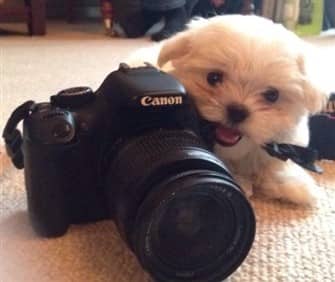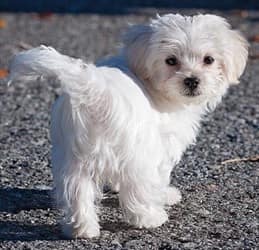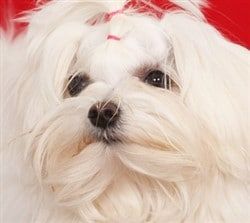Maltese Puppy Care
-min-500x279-1920w.jpg)
Overview
While there are a lot of components to taking proper care of a Maltese puppy, once you have prepared, have all the right supplies, and understand the schedule for each important task, you will soon find that raising a young Maltese puppy is extremely rewarding. In fact, your new Maltese will soon become an invaluable member of your family.
Here, we will go over the most important care elements, starting with bringing your new puppy home, and including setting up the right environment, all grooming, feeding, exercise, training, and other vital pieces.
Please note:
PetMaltese is reader-supported. Some of the product suggestions on this page are affiliate links. As an Amazon Associate we earn from qualifying purchases. This is at no extra cost to you and helps us continue creating useful content.
Expected Behavior and Energy Levels of Maltese Puppies
Puppies have tons of energy; however, they can wear out quickly. It is normal for a Maltese puppy to be extremely hyper, running to and fro, and seemingly being a ball of fire. Within the blink of an eye, he may then be napping. So, this can be a very amusing time that keeps you on your toes.
Young puppies can sleep anywhere from 18 to 20 hours per day; this includes both nighttime sleeping and naps taken throughout the day. The need for so much sleep will gradual decrease; 12 to 14 hours is typical for most adult dogs.
Around the 6 month mark, many pups will be a bit calmer, as they will have experience in most of what they see, hear, smell, and interact with.
By the 9 to 12 month mark, puppies will be much calmer, as they will be very accustomed to their routines, will be trained, and will have better self-control.
Transitioning Your Maltese Puppy into His New Home
While this will be a very exciting time for you and it will be for your puppy as well, this can also be a stressful event for a little pup that is leaving all he knows behind.
There are some steps you can take to help make this huge change a bit easier for such a tiny dog.
1)
Have all needed supplies.
We will go into more detail ahead; however, it is best if you have all of your basic necessities in place so that you do not need to scramble for forgotten items.
2) Proof your house ahead of time.
Every single room that it is even possible that the puppy may enter should be puppy-proofed.
Never underestimate what a puppy will mouth. Soon, your new Maltese puppy will be teething, which will cause him to want to chew everything he can. And puppies will often mouth things just to find out what they are.
All small objects should be placed away. Cords should be wrapped with cord concealer. Shoes, bags, and other personal items should be moved to locations off of the floor.
Milo, photo courtesy of Urvi Sedani
Puppy Supplies & Setting up the Right Environment
You will find that things will work out well if your Maltese puppy has his own area. And, within that area, are items that will keep him happy, comfortable, and well-taken care of.
A designated area is important for several reasons:
1. To help with housebreaking.
Until your puppy is fully house trained, this will keep messes and accidents limited to one location. If not, a new puppy will pee and poo just about everywhere. Not only can this be overwhelming to properly clean, any trace odors are a signal to repeat the action there.
2. To keep his important teething toys near him. Maltese puppies begin teething around the 3 to 4 month mark. During this time, there is a much better chance that your pup will seek out his toys for comfort if they are very easily accessible. This also limits chewing on non-toy items.
3. For when a pup is home alone.
Most puppies do not handle being alone very well, and this can increase as each month goes by as the Maltese puppy is becoming more aware of his surroundings. Part of resolving separation anxiety issues
involves supplying the pup with his own 'den' for a feeling of security.
4. Keeps the puppy safe.
Any time that you cannot keep your Maltese puppy close by your side, having him in his area will keep him out of trouble.
This is also for when these are lots of visitors to the home, as a place to have him rest if you are running the vacuum or doing other cleaning, and any other times that you need him off of the floor.
Methods for providing a designated area:
Do not use a crate.
Crates are terribly confining, and being in such a small area can cause both physical and emotional stress. In addition, keeping a puppy in a very small crate does not help with housebreaking at all. Puppies have very little bladder and bowel control and will go to the bathroom when the body needs to; they cannot 'hold it in'.
Gates are an option; however, these do have some cons. If you gate off an entire room, this may remove the element of a puppy feeling secure. In addition, the entire gated off area will need to be constantly puppy-proofed.
Indoor canine playpens are a great choice.
These offer a big enough area for a puppy to move around and play, and also to hold all of his important belongings. However, these are small enough that it keeps the pup confined to one area to control messes and provide a feeling of safety. These can also be easily moved from one room to the other.
A really great playpen for Maltese is the IRIS 24'' 4-Panel Pet Playpen with Door
 which is ideal for both puppies and small adults that cannot jump over the 2-foot clearance height. It is open-topped, made of heavy-duty plastic, has a door for easy in-and-out (which can be left open when you're there to supervise), is portable so you can experiment with location, and comes in 7 different colors.
which is ideal for both puppies and small adults that cannot jump over the 2-foot clearance height. It is open-topped, made of heavy-duty plastic, has a door for easy in-and-out (which can be left open when you're there to supervise), is portable so you can experiment with location, and comes in 7 different colors.
As an added bonus, that playpen can be expanded to be just about any size you wish with add-on panels that simply snap into place.
If your Maltese happens to be on the large size (10 pounds or over) or has proven themselves to be adapt at leaping over things, there is a 34" high design.

Bella “Chulita”, at 8 months old,
photo courtesy of The Maldonado Family
Other supplies for your Maltese puppy include:
Toys.
Never underestimate what the right toy collection
can provide.
These can cure teething woes, offer entertainment, keep jaws strong, provide interaction and serve as companions when a pup is by himself, are a method of doling out food (treat-release toys), and will help you bond with your puppy via games such as fetch.
Pee-pads.
While we recommend outdoor training, pee pads are often used until the pup is fully trained. These can line his pen, so that any accidents are contained with an easy-to-clean method.
Food and snacks. Choosing
the best food for your Maltese will be one of your most important decisions.
What you feed your puppy now will have a big impact on both his current and long-term health.
This breed is prone to having a sensitive stomach, and such things as artificial and chemical additives can cause issues ranging from gastrointestinal upset, to dry skin problems, to coat issues.
A quality bed.
A good bed is recommended for several reasons:
- Tiny pups are too small to sleep in an owner's bed without risking injury from being rolled onto or falling off of the bed.
- A small canine bed placed within a dog's playpen helps create the 'den' feeling of security.
- Beds are also great for helping a Maltese puppy stay warm, since both being small and having a single coat of hair often leads to this breed feeling chilled.
- A great bed will offer proper support and eliminate wear on the body that can happen if a dog is constantly lying on the floor.
One of the better picks for this breed is the K&H Self-Warming Lounge Bed
 which keeps a toy breed cozy and warm via a material that radiates back body heat.
which keeps a toy breed cozy and warm via a material that radiates back body heat.
Bowls.
Stainless-steel (or a second choice of ceramic) dishes should be used. Plastic, even if it is BPA free, can cause a range of issues including discoloration of the nose, and allergic reactions.
Since Maltese puppies are very tiny, you will want the bowls to be shallow and small so that the pup can eat and drink with ease.
You will find that having a bowl set that is secured into a non-slip base keeps the bowls in place and messes to a minimum. Alternatively, you may wish to use a separate, non-slip mat.
Leash, collar, harness.
While it may seem natural to have a collar for your puppy, you may want to consider opting for a harness instead. This can help avoid neck injuries, including the serious health issue of collapsed trachea.
Since the harness is only placed on during walks, you will want a small collar for ID purposes. Be sure that your cell number is engraved on the ID tag, and you may want to add your email as well.
For a leash, a retractable leash is best so that it can be adjusted accordingly for housebreaking, walking, and outside playtime.
Car seat.
Keeping your Maltese safe while you are traveling
with him is a vital part of providing care; there are over 16,000 vehicle accidents in the US each day. If a puppy or dog is unrestrained, an accident can lead to terrible injury and even death.
Booster seats sized for toy breed dogs are best, and keeping your pup safe in a car seat will also reduce motion sickness issues.
Optional, carry method.
There may be plenty of times that you want to hold your Maltese puppy, but doing so would involve dangerous multi-tasking. And while you may be able to keep your puppy on a leash, this is not always viable depending on where you are.
A great option to consider is a safe canine sling; these are soft bags that cradle a dog right by your hip.
Grooming supplies.
For properly grooming your Maltese, you'll want to have shampoo, conditioner, a leave-in spritz, and body grooming wipes to keep both skin and coat clean and healthy. Also, a comb, brush (pin or bristle, depending on coat length), and a mat-remover, if the coat is long enough to tangle.
A quality paw wax like Musher's Secret Paw Protection Wax
 can offer a pup better traction and protect paws in the summer (hot surfaces, tiny sand pebbles) and in the winter (frozen surfaces, bits of ice and snow wedging between paw pads).
can offer a pup better traction and protect paws in the summer (hot surfaces, tiny sand pebbles) and in the winter (frozen surfaces, bits of ice and snow wedging between paw pads).
Continue reading about grooming a Maltese puppy or dog.
Taking Your Maltese Puppy Outside
Until two weeks have passed since your Maltese puppy has had all of his puppy shots (typically at the 4 to 4.5 month mark), you will want to avoid taking your pup out into public areas.
This is because while he is still in the process of receiving his inoculations, antibodies passed to him from the dam are wearing off, but his body has not yet built up enough antibodies from the vaccinations.
During this time, puppies are susceptible to disease and infection. Do not bring him to any areas in which there could have been dogs present.
You may bring him out to your own private yard; however, if you have any other dogs that visit that area, be sure that they are up-to-date with their own boosters.

Schedules for Maltese Puppies
Grooming
- You can start giving a Maltese puppy a bath
as soon as you bring him home at 8 weeks old. Baths should be given once every 3 weeks.
You will want to brush your Maltese
at least once every 3 days, even if the coat does not appear to need it. This is because as your pup matures, he will need to be brushed at least this often, and it is a good idea to allow him to become accustomed to this sort of touch and handling.
Brushing also stimulates hair follicles, massages the skin, and helps distribute natural body oils, which are all elements that contribute to healthy skin and coat.
Exercise
- Most Maltese puppies are roaring with energy and you'll want your pup to be able to burn some of that off via outdoor exercise. This can help him remain calmer when inside the home. Additionally, starting your puppy on an exercise routine
sets up a healthy foundation for the rest of his life.
Maltese puppies should be walked at least twice per day, for 20 to 30 minutes, and at a pace that is brisk for the pup.
A Final Word
Your Maltese will only be a puppy for one year; this breed becomes an adult at the 1 year mark. This is a small window of time to truly enjoy this phase and an important one for establishing good habits, good behavior, and proper care elements.
Effective methods that can make a world of difference
Related:
Maltese Puppy Vaccination Schedule
- Which shots your little guy or gal needs, possible reactions, core vs non-core, and other FAQ about immunizations.
Are You a Member Yet?
Become a free PetMaltese Member
to stay informed regarding new Maltese information.

-min-450x169-1920w.jpg)



